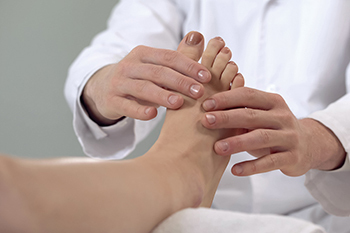Blog
Items filtered by date: January 2025
Breathe Better with Halo Therapy
 Halo therapy, also called salt therapy, is a natural way to feel healthier. It can help people with breathing problems like asthma, chronic bronchitis, and other lung issues. During treatment, tiny salt particles are inhaled, reducing inflammation and easing allergy symptoms. This calming therapy can also help the body respond less strongly to things that cause asthma flare-ups. Studies show that halo therapy supports the body’s natural healing process, making breathing easier and reducing symptoms of long-term respiratory problems. Many patients notice they feel more relaxed and comfortable after a session. If you are dealing with lung or allergy issues, contact a chiropractor offering halo therapy who can provide this treatment as part of a holistic wellness plan.
Halo therapy, also called salt therapy, is a natural way to feel healthier. It can help people with breathing problems like asthma, chronic bronchitis, and other lung issues. During treatment, tiny salt particles are inhaled, reducing inflammation and easing allergy symptoms. This calming therapy can also help the body respond less strongly to things that cause asthma flare-ups. Studies show that halo therapy supports the body’s natural healing process, making breathing easier and reducing symptoms of long-term respiratory problems. Many patients notice they feel more relaxed and comfortable after a session. If you are dealing with lung or allergy issues, contact a chiropractor offering halo therapy who can provide this treatment as part of a holistic wellness plan.
Halo therapy, also known as salt therapy, is a natural treatment that involves inhaling microscopic salt particles in a controlled environment, often a salt room or salt cave. This practice is gaining popularity for its potential health benefits, particularly for respiratory and skin conditions.
The therapy works by dispersing finely ground salt into the air. When inhaled, these particles may help reduce inflammation, loosen mucus, and clear airways, offering relief for asthma, allergies, sinus issues, and bronchitis. Salt's antibacterial and anti-inflammatory properties also make it beneficial for skin concerns such as eczema and psoriasis.
Many patients find that combining salt therapy with chiropractic care enhances relaxation, supports better breathing, and complements overall health goals. It is a simple, drug-free way to promote well-being naturally.
1. Will salt therapy dehydrate my skin or body?
No. The microscopic salt particles used in halo therapy do not cause dehydration. Instead, they can benefit the skin by reducing irritation and promoting healing in conditions like eczema.
2. Can I do salt therapy while pregnant?
Yes, salt therapy is generally safe for pregnant individuals. It may help alleviate respiratory discomfort and sinus congestion common during pregnancy.
Managing Degenerative Disc Disease with Chiropractic Care
 Degenerative disc disease, or DDD, is a condition where spinal discs gradually lose hydration and flexibility, leading to reduced cushioning between vertebrae. This wear and tear can result in pain, stiffness, and reduced mobility, especially in the neck and lower back, as discs lose their shock-absorbing ability. Individuals often experience persistent or intermittent pain that may radiate to nearby areas, creating a sense of deep aching or sharp discomfort, particularly during movement or prolonged sitting. While anyone can develop DDD, it’s more common with aging, affecting individuals over 40 years old, or those with repetitive spinal strain or injuries. Chiropractic care offers a safe, non-invasive approach to managing DDD symptoms. Chiropractors use gentle adjustments and tailored exercises to relieve pressure on affected discs, helping improve mobility, alleviate pain, and restore function without resorting to surgery or medication. If you have this type of pain, it is suggested that you schedule an appointment with a chiropractor for care.
Degenerative disc disease, or DDD, is a condition where spinal discs gradually lose hydration and flexibility, leading to reduced cushioning between vertebrae. This wear and tear can result in pain, stiffness, and reduced mobility, especially in the neck and lower back, as discs lose their shock-absorbing ability. Individuals often experience persistent or intermittent pain that may radiate to nearby areas, creating a sense of deep aching or sharp discomfort, particularly during movement or prolonged sitting. While anyone can develop DDD, it’s more common with aging, affecting individuals over 40 years old, or those with repetitive spinal strain or injuries. Chiropractic care offers a safe, non-invasive approach to managing DDD symptoms. Chiropractors use gentle adjustments and tailored exercises to relieve pressure on affected discs, helping improve mobility, alleviate pain, and restore function without resorting to surgery or medication. If you have this type of pain, it is suggested that you schedule an appointment with a chiropractor for care.
Degenerative Disc Disease
Degenerative disc disease, or DDD, is a condition characterized by the gradual wear and tear of the spinal discs, which act as cushions between vertebrae. As these discs deteriorate, they lose height, elasticity, and hydration, resulting in reduced shock absorption and increased friction between bones. This degeneration can lead to chronic pain, stiffness, and decreased mobility, often radiating to other areas of the body due to nerve irritation.
Management of Degenerative Disc Disease
Chiropractors manage degenerative disc disease by reducing stress on the spine and enhancing mobility to alleviate discomfort. They use targeted spinal adjustments to help improve alignment, which minimizes nerve compression and promotes better disc health. By restoring spinal balance, chiropractic care can help reduce pain and prevent further degeneration.
Complementary treatments like stretching exercises, strengthening routines, and postural training often accompany chiropractic adjustments to provide a comprehensive approach to managing DDD. These additional therapies aim to enhance flexibility, reinforce supporting muscles, and protect the spine from further strain.
Chiropractic care focuses on a non-invasive, holistic approach, offering relief without reliance on medication or surgery. By addressing the underlying mechanics of the spine, chiropractors work to help patients manage DDD symptoms effectively and enjoy improved quality of life over time.
1. How often should someone with degenerative disc disease see a chiropractor?
The frequency of visits varies based on individual needs, but patients often benefit from regular treatments initially, which can then be adjusted as symptoms improve or stabilize.
2. Will chiropractic care stop the progression of degenerative disc disease?
While chiropractic care cannot reverse the condition, it can help alleviate symptoms, reduce pain, and improve quality of life, making it easier to stay active, which may slow progression over time.
3. How does a chiropractor evaluate the progression of degenerative disc disease over time, and can they adjust their techniques as the condition evolves?
Chiropractors typically monitor changes in mobility, pain levels, and overall function, adjusting their treatment plans to accommodate increased sensitivity or stiffness as the disease progresses.
4. Does chiropractic care provide long-term relief for degenerative disc disease?
While chiropractic care may not cure degenerative disc disease, regular treatment can offer long-term relief by managing pain, reducing inflammation, and improving joint mobility, which can enhance quality of life over time.
If you have any questions please feel free to contact our office located in Bellmore, NY .
Understanding Anterior Knee Pain
 Anterior knee pain refers to pain at the front of the knee, often around or behind the kneecap. It is common in people who play sports, run, or spend a lot of time on their feet. This type of knee pain can make everyday movements, like squatting, climbing stairs, or even sitting for a long time uncomfortable or painful. People often describe the pain as a dull ache, which can get worse with certain activities. Chiropractic care offers a natural way to help relieve anterior knee pain. Chiropractors look at how the knee aligns with the rest of the body and use gentle adjustments to reduce strain on the joint. They might also suggest exercises to strengthen the muscles that support the knee, helping to relieve pressure and improve stability, often without the need for medications or surgery. If you have pain around your knee, it is suggested that you see a chiropractor for treatment.
Anterior knee pain refers to pain at the front of the knee, often around or behind the kneecap. It is common in people who play sports, run, or spend a lot of time on their feet. This type of knee pain can make everyday movements, like squatting, climbing stairs, or even sitting for a long time uncomfortable or painful. People often describe the pain as a dull ache, which can get worse with certain activities. Chiropractic care offers a natural way to help relieve anterior knee pain. Chiropractors look at how the knee aligns with the rest of the body and use gentle adjustments to reduce strain on the joint. They might also suggest exercises to strengthen the muscles that support the knee, helping to relieve pressure and improve stability, often without the need for medications or surgery. If you have pain around your knee, it is suggested that you see a chiropractor for treatment.
Knee Pain
Knee pain is a frequent complaint that can arise from injuries, overuse, arthritis, or misalignments in the body. This pain can disrupt daily life, limiting movement and impacting quality of life. Knee discomfort often develops when the body’s structural alignment is off, which places extra strain on the knee joint and surrounding muscles and ligaments.
Chiropractic care focuses on reducing knee pain by assessing and addressing alignment throughout the lower body. Gentle adjustments may be used to realign the knee and correct imbalances in the hip, pelvis, and spine that contribute to excessive knee stress. Restoring alignment in these areas can relieve pressure on the joint, ease pain, and promote improved mobility.
To support these adjustments, chiropractors often incorporate exercises, stretches, and lifestyle guidance to improve strength and flexibility around the knee. Strengthening muscles surrounding the joint can offer additional stability, helping to prevent future injuries.
Is knee pain treatment going to be painful?
Patients may worry that adjustments or other treatments will hurt. Chiropractors reassure patients that the techniques used are generally gentle, with any discomfort being mild and short-lived. They work within the patient’s pain tolerance.
How many sessions will I need?
Frequency and number of sessions depend on the pain’s severity and the patient’s response to treatment. Chiropractors often suggest a treatment plan tailored to the individual, sometimes starting with frequent visits and tapering as improvement occurs.
If you have any questions please feel free to contact our office located in Bellmore, NY .
Understanding Muscle Spasms
 Muscle spasms are sudden, involuntary contractions that cause sharp pain and can momentarily immobilize the affected muscle. They can occur in any muscle but are common in the back, neck, and legs. Spasms typically result from muscle strain, dehydration, or electrolyte imbalances, which disrupt normal muscle function. Physical exertion, especially in hot conditions, can lead to dehydration and electrolyte loss, increasing the risk. Athletes, individuals with physical labor-intensive jobs, and those who sit for prolonged periods are particularly prone to muscle spasms. Age and certain medical conditions, like nerve issues or diabetes, also increase susceptibility. Spasms are often minor and resolve independently, but frequent or severe episodes might signal underlying issues. Visiting a chiropractor can help alleviate tension and promote muscle balance through adjustments, stretching, and strengthening exercises, potentially reducing the frequency and intensity of muscle spasms. If you have frequent and painful muscle spasms, it is suggested that you see a chiropractor for care.
Muscle spasms are sudden, involuntary contractions that cause sharp pain and can momentarily immobilize the affected muscle. They can occur in any muscle but are common in the back, neck, and legs. Spasms typically result from muscle strain, dehydration, or electrolyte imbalances, which disrupt normal muscle function. Physical exertion, especially in hot conditions, can lead to dehydration and electrolyte loss, increasing the risk. Athletes, individuals with physical labor-intensive jobs, and those who sit for prolonged periods are particularly prone to muscle spasms. Age and certain medical conditions, like nerve issues or diabetes, also increase susceptibility. Spasms are often minor and resolve independently, but frequent or severe episodes might signal underlying issues. Visiting a chiropractor can help alleviate tension and promote muscle balance through adjustments, stretching, and strengthening exercises, potentially reducing the frequency and intensity of muscle spasms. If you have frequent and painful muscle spasms, it is suggested that you see a chiropractor for care.
Muscle Spasms
Muscle spasms, or involuntary muscle contractions, can cause sudden pain and tightness, often disrupting daily activities and causing significant discomfort. Spasms are typically triggered by muscle strain, dehydration, poor circulation, or nerve irritation and can occur in any muscle, although they are most common in the neck, back, and legs.
Chiropractic care for muscle spasms aims to relieve muscle tension, improve circulation, and restore the body’s natural balance. By performing gentle adjustments to the spine or other affected areas, chiropractors work to realign the body and reduce nerve interference that may be contributing to the spasms. This approach can help relieve the pressure on muscles, encouraging them to relax and reducing the frequency and intensity of future spasms.
In addition to adjustments, chiropractic care may include stretching exercises, massage, and lifestyle recommendations to prevent recurrence. These exercises are designed to strengthen and support the muscles, improving flexibility and reducing muscle strain.
Chiropractic care offers a holistic, drug-free approach to managing muscle spasms, emphasizing long-term relief and muscle health. By addressing both the immediate symptoms and underlying causes, chiropractic treatment helps people find lasting relief, promoting muscle relaxation and supporting overall well-being.
Will the treatment cause additional pain or discomfort?
Patients sometimes worry that chiropractic adjustments or muscle manipulation will aggravate their spasms. Chiropractors emphasize that treatments are generally gentle and designed to alleviate discomfort without causing additional pain.
Will I feel immediate relief after each adjustment, or does it build over time?
While some patients feel immediate relief after a session, long-term improvement usually develops gradually with consistent treatment. Muscle tension and spasms often respond best to cumulative care over several sessions.
If you have any questions please feel free to contact our office located in Bellmore, NY .
